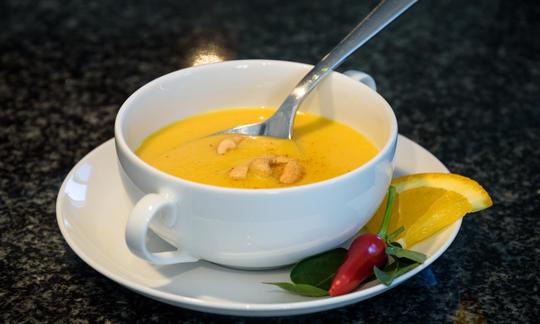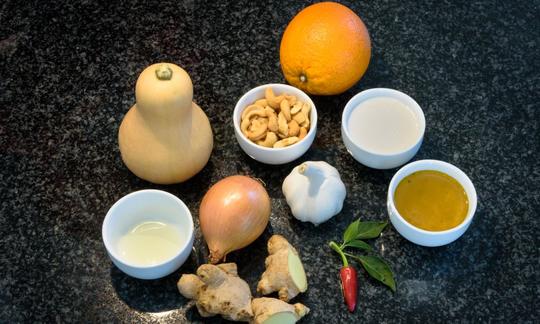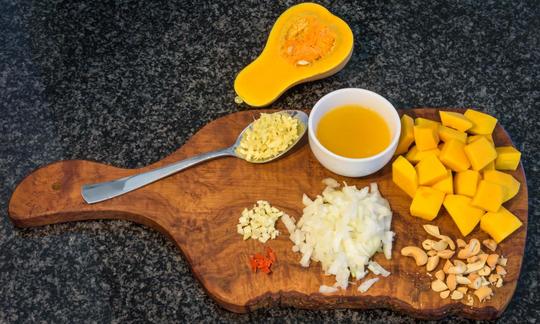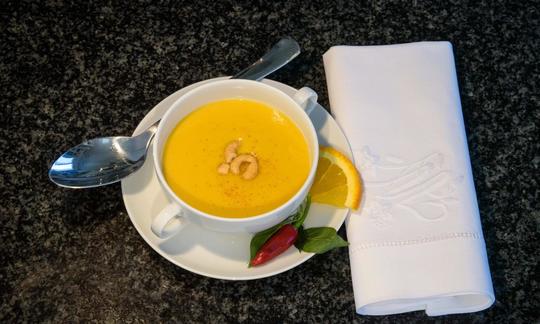Fiery Butternut Squash Soup with Ginger and Coconut Milk
vegan
Ingredients (for servings, )
| For the soup | |
|---|---|
| 1 | Onions, raw (organic?) (3.9 oz) |
| 1 clove | Garlic (organic?) (0.11 oz) |
| 1 tbsp | Rapeseed oil (canola, HOLL oil, kernel oil), cold pressed?, organic? (0.49 oz) |
| 1 tsp | Ginger, raw (organic?) (0.07 oz) |
| ½ | Chili peppers, red, raw (organic?) (0.09 oz) |
| 14 oz | Butternut squash, raw (pear squash), one butternut squash |
| 100 ml | Coconut milk, preserved (coconut milk, organic?) (3.4 oz) |
| 100 ml | Vegetable broth with little salt (organic?) (3.5 oz) |
| Seasoning | |
| 1 dash | Table salt (table salt, raw?, organic?) (0.01 oz) |
| 1 dash | Black pepper (organic?, raw?) (0.00 oz) |
| 1 dash | Paprika powder, hot (raw?, organic?) (0.00 oz) |
| ½ | Oranges, raw (organic?) (2.3 oz) |
| Garnish | |
| 1 ¾ oz | Cashew nuts, roasted, unsalted (raw?, organic?) |
Equipment
- hand-held blender / immersion blender or blender
- vegetable peeler
- stove
- citrus juicer (lemon squeezer)
- saucepan
Type of preparation
- cook
- chop or grind
- squeeze
- sweat
- season to taste
- sauté
- purée
- deglaze
- remove the skin
- peel
Preparation
For the soup
Finely chop the onion and garlic cloves, place in a saucepan, and sweat in the oil until soft.Peel the ginger and chop very finely (alternatively: grate). Peel the butternut squash with a vegetable peeler and then cut into small cubes. Remove the seeds from the chili pepper and finely chop.
Add the chopped ginger and butternut squash to the onions and sauté briefly.
Add the chili pepper and then shortly thereafter deglaze with the broth and coconut milk. Cover the saucepan and simmer on low heat for 15 minutes.
Remove the saucepan from the heat and purée the soup until smooth. Squeeze the half of orange and then add the juice.
Seasoning
Season the fiery butternut squash soup with salt, pepper, and ground paprika.You can decide here whether you prefer to use a hot or sweet variety of ground paprika. Before serving, you can also sprinkle a little ground paprika on top as the red makes for a nice color contrast.
For the garnish
Ladle the fiery butternut squash soup into soup bowls and garnish with the chopped cashews.
|
Nutritional Information per person
Convert per 100g
|
2000 kcal | |
|---|---|---|
| Energy | 381 kcal | 19.1% |
| Fat/Lipids | 29 g | 42.0% |
| Saturated Fats | 12 g | 60.3% |
| Carbohydrates (inc.dietary fiber) | 28 g | 10.3% |
| Sugars | 13 g | 14.4% |
| Fiber | 4.6 g | 18.3% |
| Protein/Albumin | 7.9 g | 15.7% |
| Cooking Salt (Na:210.6 mg) | 535 mg | 22.3% |
| Essential micronutrients with the highest proportions | per person | 2000 kcal | |
|---|---|---|---|
| Vit | Vitamin A, as RAE | 917 µg | 115.0% |
| Min | Copper, Cu | 0.89 mg | 89.0% |
| Vit | Vitamin C (ascorbic acid) | 63 mg | 79.0% |
| Min | Manganese, Mn | 1.0 mg | 52.0% |
| Elem | Potassium, K | 846 mg | 42.0% |
| Vit | Vitamin B9, B11 (Folate, as the active form of folic acid) | 83 µg | 41.0% |
| Prot | Tryptophan (Trp, W) | 0.10 g | 40.0% |
| Fat | Alpha-Linolenic acid; ALA; 18:3 omega-3 | 0.77 g | 39.0% |
| Elem | Magnesium, Mg | 137 mg | 37.0% |
| Elem | Phosphorus, P | 256 mg | 37.0% |
Detailed Nutritional Information per Person for this Recipe
The majority of the nutritional information comes from the USDA (US Department of Agriculture). This means that the information for natural products is often incomplete or only given within broader categories, whereas in most cases products made from these have more complete information displayed.
If we take flaxseed, for example, the important essential amino acid ALA (omega-3) is only included in an overarching category whereas for flaxseed oil ALA is listed specifically. In time, we will be able to change this, but it will require a lot of work. An “i” appears behind ingredients that have been adjusted and an explanation appears when you hover over this symbol.
For Erb Muesli, the original calculations resulted in 48 % of the daily requirement of ALA — but with the correction, we see that the muesli actually covers >100 % of the necessary recommendation for the omega-3 fatty acid ALA. Our goal is to eventually be able to compare the nutritional value of our recipes with those that are used in conventional western lifestyles.
| Essential fatty acids | per person | 2000 kcal |
|---|---|---|
| Alpha-Linolenic acid; ALA; 18:3 omega-3 | 0.77 g | 39.0% |
| Linoleic acid; LA; 18:2 omega-6 | 3.4 g | 34.0% |
| Essential amino acids | per person | 2000 kcal |
|---|---|---|
| Tryptophan (Trp, W) | 0.10 g | 40.0% |
| Threonine (Thr, T, irreversibly transaminated) | 0.25 g | 27.0% |
| Valin (Val, V) | 0.43 g | 27.0% |
| Isoleucine (Ile, I) | 0.31 g | 25.0% |
| Leucine (Leu, L) | 0.53 g | 22.0% |
| Phenylalanine (Phe, F) | 0.34 g | 22.0% |
| Lysine (Lys, K, irreversibly transaminated) | 0.39 g | 21.0% |
| Methionine (Met, M) | 0.12 g | 13.0% |
| Vitamins | per person | 2000 kcal |
|---|---|---|
| Vitamin A, as RAE | 917 µg | 115.0% |
| Vitamin C (ascorbic acid) | 63 mg | 79.0% |
| Vitamin B9, B11 (Folate, as the active form of folic acid) | 83 µg | 41.0% |
| Vitamin B6 (pyridoxine) | 0.40 mg | 29.0% |
| Vitamin K | 21 µg | 27.0% |
| Vitamin B1 (Thiamine) | 0.22 mg | 20.0% |
| Vitamin E, as a-TEs | 1.8 mg | 15.0% |
| Vitamin B5 (Pantothenic acid) | 0.86 mg | 14.0% |
| Vitamin B2 (Riboflavin) | 0.16 mg | 12.0% |
| Vitamin B7 (Biotin, ex vitamin H) | 6.1 µg | 12.0% |
| Vitamin B3 (Niacin) | 1.7 mg | 11.0% |
| Essential macroelements (macronutrients) | per person | 2000 kcal |
|---|---|---|
| Potassium, K | 846 mg | 42.0% |
| Magnesium, Mg | 137 mg | 37.0% |
| Phosphorus, P | 256 mg | 37.0% |
| Sodium, Na | 211 mg | 26.0% |
| Calcium, Ca | 91 mg | 11.0% |
| Essential trace elements (micronutrients) | per person | 2000 kcal |
|---|---|---|
| Copper, Cu | 0.89 mg | 89.0% |
| Manganese, Mn | 1.0 mg | 52.0% |
| Iron, Fe | 4.2 mg | 30.0% |
| Zinc, Zn | 2.4 mg | 24.0% |
| Selenium, Se | 4.0 µg | 7.0% |
| Iod, I (Jod, J) | 4.1 µg | 3.0% |
| Fluorine, F | 1.4 µg | < 0.1% |
Fiery butternut squash soup with ginger and coconut milk tastes fruity and creamy. The ginger and chili pepper make for the perfect flavor combination.
Butternut squash: Butternut squash has bright orange flesh and a buttery, nutty flavor that melts in your mouth. It contains high amounts of beta carotene.
Level of spice: Chili peppers, which are in the same family as bell peppers, have a wide range of spiciness. It is important to note that small chili peppers are not always the spiciest.
Coconut milk is not coconut water: Coconut milk is made by puréeing the flesh of a coconut with water and then straining through a cheesecloth. The result is a milky liquid that has a fat content of about 15 to 25 %. If you run boiling water over the remaining fibrous pulp and then squeeze the cheesecloth out again, you will obtain more coconut milk, but it will be somewhat thinner.
Coconut water, not to be confused with coconut milk, is the clear liquid found inside young coconuts. Coconut milk is available commercially and is used as a milk substitute for tea, coffee, and baked goods.
Ginger: Ginger is not only used as a spice, but it is also effective against colds, inflammation, and nausea. Gingerol and the essential oil contained in ginger are responsible for ginger’s medicinal effects. Gingerol can kick-start your digestion by stimulating the production of gastric juice.
Storing butternut squash: One way to store butternut squash is to freeze it. To do this, cut into cubes, blanch for 1–2 minutes in well-salted boiling water, drain, and then let cool.
Seeds: Butternut squash seeds can be eaten and they have a pleasant, nutty taste. You can snack on them raw or brown them briefly in a skillet and then lightly salt.
Working with chili peppers: It is best to use gloves when working with chili peppers because contact with your skin can cause you to experience a tingling or even burning sensation. And if you then touch your eyes, especially if you wear contacts, the result can be very painful. This can be the case even if it’s been 1 or 2 hours since you touched the chili peppers themselves.
Season carefully: At first, only add a small amount of chili pepper, and then if necessary you can add more. When cooked, the alkaloid capsaicin responsible for the spice dissolves in the dish and distributes the spiciness. Contrary to some assumptions, however, cooking does not lead to an increase in spiciness, it only distributes the spiciness.
Pumpkin: Instead of butternut squash, you can also use Hokkaido pumpkin (red curry squash).
Nuts: You can easily replace the cashews with peanuts. If you choose to use cashews, we recommend that you choose a variety that has been treated only by steam or raw cashews (peeled by hand).
Cilantro: Adding cilantro to this dish gives it a Thai flair.










